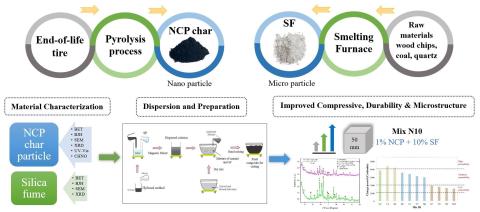You are here
Enhancing the Interface of Cement-paste Composite by Dispersing Sustainable Nano-Carbon Pyrolytic Char with Silica fume: A Sustainable and Effective approach
Pages :
-

Discrete studies are performed on the reuse of end-of-life tires in the construction industry as their accumulation is a global concern to the environment. In consequence, the desired focus of this work is to understand the interaction of powder derived from recycling process of tire waste which yet to be ascertained. The powder yielded through pyrolysis treatment of tire waste is carbon rich and nano in size. On the other hand, Silica Fume (SF) as a micro material is greatly utilized as cement replacement to reduce the environment impact. Therefore, the compressive strength and microstructure properties of cement paste is investigated by incorporating Nano-Carbon Pyrolytic char (NCP) (0.5% & 1%) and SF (0, 2.5, 5, 7.5, 10%) as an additive and filler, respectively, to the weight of cement. The compressive strength of cement paste is ascertained after 1, 3, 7, 14, & 28 days by employing 50mm3 cube specimen; and the durability properties such as sorptivity, rapid chloride permeability test, and acid test on the samples were examined. Further, Scanning Electron Microscope (SEM) and X-ray Diffraction (XRD) analysis is performed to determine the microstructural properties. Finite element analysis used to model the cubes to validate the experimental findings with analytical results. From the results, the individual addition NCP char (0.5% & 1%) in cement paste reduced the compressive strength of the matrix. Further, the effectiveness of SF directly influences the strength property and separates the agglomerates of NCP char in cement paste. The cement paste incorporated with 1% of NCP char as Nano and 10% SF as micro blends improved the compressive strength by 18.56%. Furthermore, the Nano/micro blends in cement paste reacts with Ca(OH)2 to produce dense C-S-H formation due to their reinforcing capability resulting in better durability properties. Finite element analysis exhibit less than 10% of error compared to experimental values. Eventually, the influence of NCP char results in the development of new sustainable nano composites.
